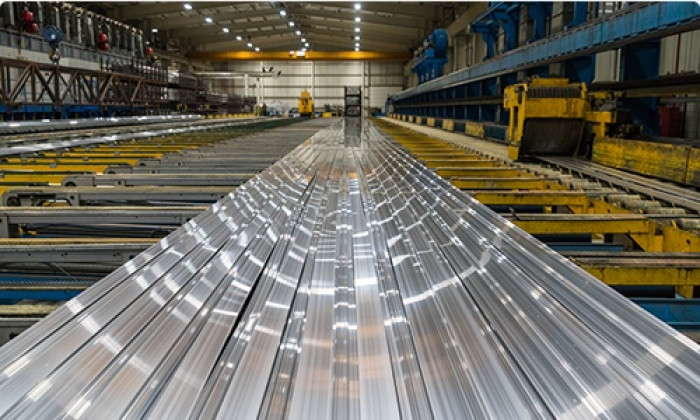The automotive sector may have traditionally been strongly associated with the extensive utilisation of steel, but that picture has changed rapidly in recent years, as the industry has undergone one of its most profound evolutions since the invention of the internal combustion engine (ICE).
Aluminium is gaining in importance in the automotive industry
On a backdrop of environmental pressures, safety, efficiency, and cost-effectiveness being some of the defining priorities for today’s automotive sector, it shouldn’t be so surprising that aluminium now sees such strong demand for use in personal and commercial vehicles.
Aluminium’s combination of recyclability, light weight, corrosion resistance, great strength to weight ratio, and extremely impressive energy absorbency, allows for a rigid body structure to be achieved that also promotes weight saving and emissions reduction, without compromising safety.
But at a time when the automotive industry is shifting towards electrification – another trend in the sector that is driving the use of significantly greater aluminium content – what trends can be observed for aluminium usage in cars for 2024?
Could a potential slowdown in car production have implications for aluminium demand?
Recent research has found that the average amount of aluminium used in European cars went up by 18% between 2019 and 2022, from 174kg to 205kg. It is anticipated that this trend will continue, with the average aluminium content in a European car set to reach 237kg by 2026, and 256kg per vehicle by the end of this decade.
There can be little doubt about the extent to which electric vehicles (EVs) are set to contribute to such growth; a European-produced battery electric vehicle (BEV) contained 283kg of aluminium on average in 2022, as opposed to a mere 169kg in an ICE-only petrol or diesel car.
Such factors as the COVID-19 pandemic and a shortage of semiconductor chips have exerted downward pressure on automotive demand for aluminium over the last few years; overall output in the automotive manufacturing sector in the European Union (EU) was still, in 2022, 24% shy of 2019 pre-pandemic levels. High stock levels also saved automotive manufacturers from having to acquire as much aluminium as may have otherwise been necessary, and high metal inventories continue to depress aluminium demand.
All of this makes it a worry for the aluminium industry at a time when there are signs of a further potential slowdown in car and vehicle manufacturing. It was recently reported, for example, that new car registrations in Europe recorded their slowest growth rate of the year during September 2023.
However, the number of new cars sold in Europe in September was also still 10% above that seen in the same month of 2022. So, it is important to maintain perspective on the likely demand picture for aluminium in the car industry for 2024.
Concerns about the affordability of electric vehicles remains a headwind for the industry potentially limiting the part EVs will play in the further growth of the automotive sector.
But with the global automotive aluminium market industry still forecast to grow from USD $50.94 billion in 2022 to USD $133.51 billion by 2030, distributors of extruded aluminium products in the EU and UK will still hope for at least gradual recovery in demand for such materials throughout 2024.
The automotive sector may have traditionally been strongly associated with the extensive utilisation of steel, but that picture has changed rapidly in recent years, as the industry has undergone one of its most profound evolutions since the invention of the internal combustion engine (ICE).
Aluminium is gaining in importance in the automotive industry
On a backdrop of environmental pressures, safety, efficiency, and cost-effectiveness being some of the defining priorities for today’s automotive sector, it shouldn’t be so surprising that aluminium now sees such strong demand for use in personal and commercial vehicles.
Aluminium’s combination of recyclability, light weight, corrosion resistance, great strength to weight ratio, and extremely impressive energy absorbency, allows for a rigid body structure to be achieved that also promotes weight saving and emissions reduction, without compromising safety.
But at a time when the automotive industry is shifting towards electrification – another trend in the sector that is driving the use of significantly greater aluminium content – what trends can be observed for aluminium usage in cars for 2024?
Could a potential slowdown in car production have implications for aluminium demand?
Recent research has found that the average amount of aluminium used in European cars went up by 18% between 2019 and 2022, from 174kg to 205kg. It is anticipated that this trend will continue, with the average aluminium content in a European car set to reach 237kg by 2026, and 256kg per vehicle by the end of this decade.
There can be little doubt about the extent to which electric vehicles (EVs) are set to contribute to such growth; a European-produced battery electric vehicle (BEV) contained 283kg of aluminium on average in 2022, as opposed to a mere 169kg in an ICE-only petrol or diesel car.
Such factors as the COVID-19 pandemic and a shortage of semiconductor chips have exerted downward pressure on automotive demand for aluminium over the last few years; overall output in the automotive manufacturing sector in the European Union (EU) was still, in 2022, 24% shy of 2019 pre-pandemic levels. High stock levels also saved automotive manufacturers from having to acquire as much aluminium as may have otherwise been necessary, and high metal inventories continue to depress aluminium demand.
All of this makes it a worry for the aluminium industry at a time when there are signs of a further potential slowdown in car and vehicle manufacturing. It was recently reported, for example, that new car registrations in Europe recorded their slowest growth rate of the year during September 2023.
However, the number of new cars sold in Europe in September was also still 10% above that seen in the same month of 2022. So, it is important to maintain perspective on the likely demand picture for aluminium in the car industry for 2024.
Concerns about the affordability of electric vehicles remains a headwind for the industry potentially limiting the part EVs will play in the further growth of the automotive sector.
But with the global automotive aluminium market industry still forecast to grow from USD $50.94 billion in 2022 to USD $133.51 billion by 2030, distributors of extruded aluminium products in the EU and UK will still hope for at least gradual recovery in demand for such materials throughout 2024.

















